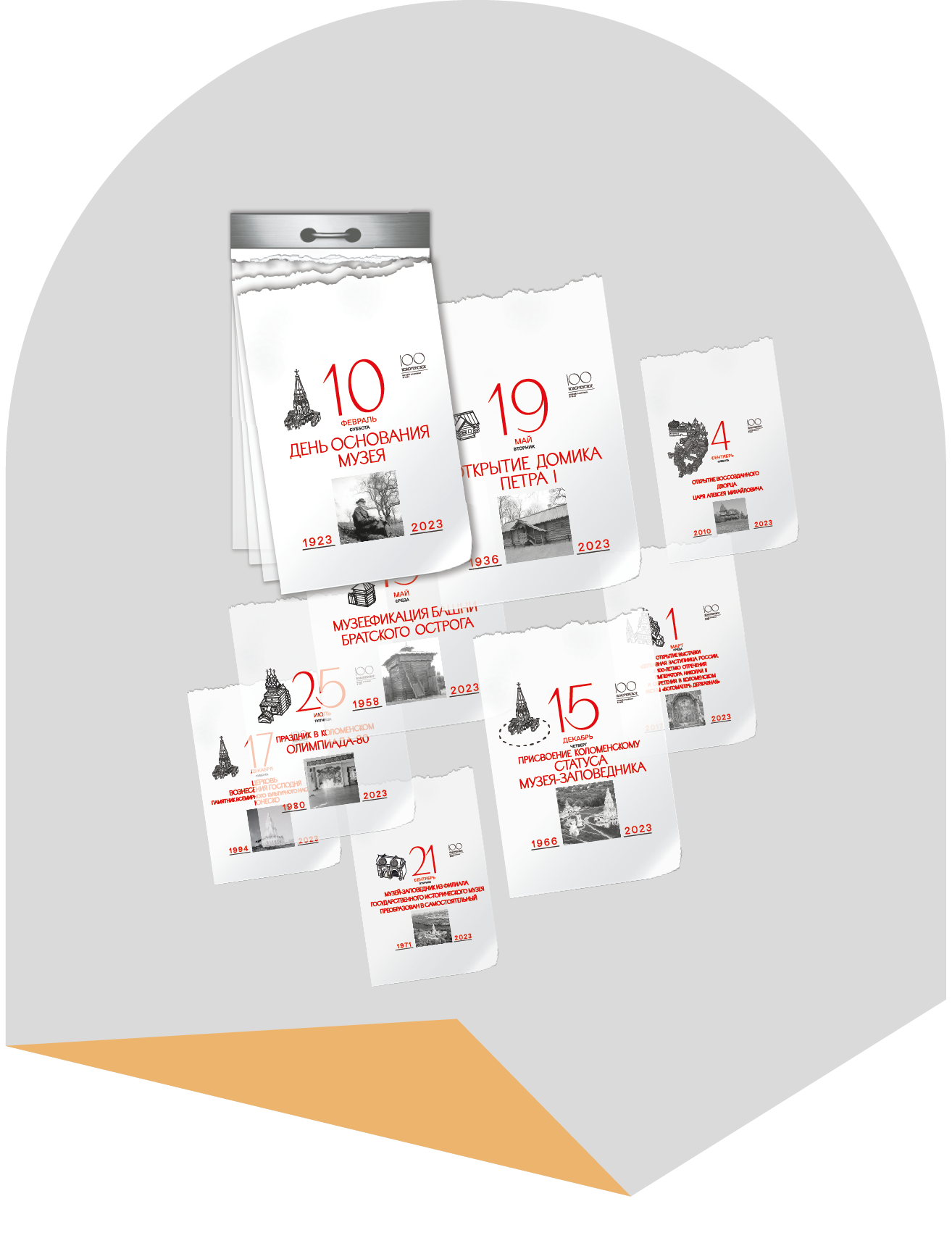Exhibitions
6+10 Days from the Life of the Kolomenskoe Museum-Reserve
Kolomenskoe
April 25 – September 10, 2023
Tue. - Thu., Sun. 10:00-18:00
Palace of Tsar Alexey Mikhailovich, Tower of the Tsar’s Daughters: bldg 69, 39 Prospekt Andropova
The exhibition that opened 25 April at the Palace of Tsar Alexey Romanov illustrates the museum’s history starting from 1923, its foundation year, up to the present day. Each of the ten ‘days’ in the display is centered on an important date of one decade, its key characters and events. You will see historical photos, archive documents and of course exhibits from the museum’s collection.
The exhibition that opened 25 April at the Palace of Tsar Alexey Romanov illustrates the museum’s history starting from 1923, its foundation year, up to the present day. Each of the ten ‘days’ in the display is centered on an important date of one decade, its key characters and events. You will see historical photos, archive documents and of course exhibits from the museum’s collection.
The museum foundation was initiated by architect Peter (Pyotr) Baranovsky. On 10 February 1923, the Russian ‘People’s Commissariat’ (the then Ministry) for Education gave him an official mandate ‘to manage the architectural sites of the Kolomenskoe-Dyakovo village’. In 1924, Kolomenskoe became a branch of the Moscow Intercession Cathedral museum and four years later – of the State Historical Museum in the Red Square. Research and scientific restoration of the architectural sites already started in these early years. The first permanent exhibitions were created and, most important, the foundation of the museum’s rich collection of Russian icons, old books as well as decorative and applied art was laid.
In 1971, Kolomenskoe became an independent and actively developing museum-reserve. In 1983, it was the first of Moscow museums to receive a specialized museum collection depository building equipped after global standards. In 2010, one of the historical sites, the wooden XVII century Palace of Tsar Alexey Romanov, known among its contemporaries as ‘the eighth wonder of the world’, was reconstructed on a new place.
To make your visit to the exhibition still more exciting, we recommend that you join a special group guided tour
Haut-relief cherub. Yaroslavl, Russia, XVII century. Wood, gesso. Kolomenskoe Museum-Reserve collection
Achille Collas: ‘Diana’s Chariot’ mantel clock. Paris, France, 1806 – 1810. Bronze, enamel, steel. Kolomenskoe Museum-Reserve collection
Grigory Kokurin: architrave of a bright (multi-window) chamber window. Nizhy Novgorod province, Russia, 1890. Wood, metal. Kolomenskoe Museum-Reserve collection
Chest. Russia, XVII century. Wood, leather, metal, mica; joiner’s work, punching, forging
Haut-relief cherub. Yaroslavl, Russia, XVII century. Wood, gesso. Kolomenskoe Museum-Reserve collection
Achille Collas: ‘Diana’s Chariot’ mantel clock. Paris, France, 1806 – 1810. Bronze, enamel, steel. Kolomenskoe Museum-Reserve collection
Grigory Kokurin: architrave of a bright (multi-window) chamber window. Nizhy Novgorod province, Russia, 1890. Wood, metal. Kolomenskoe Museum-Reserve collection
Chest. Russia, XVII century. Wood, leather, metal, mica; joiner’s work, punching, forging
Haut-relief cherub. Yaroslavl, Russia, XVII century. Wood, gesso. Kolomenskoe Museum-Reserve collection
Achille Collas: ‘Diana’s Chariot’ mantel clock. Paris, France, 1806 – 1810. Bronze, enamel, steel. Kolomenskoe Museum-Reserve collection
Grigory Kokurin: architrave of a bright (multi-window) chamber window. Nizhy Novgorod province, Russia, 1890. Wood, metal. Kolomenskoe Museum-Reserve collection
Chest. Russia, XVII century. Wood, leather, metal, mica; joiner’s work, punching, forging
The entire display embraces a huge period of time – from Neolithic Age to the middle of the XX century. Two icons, ‘Saint John the Baptist – Angel of the Desert’ (XVI century) and ‘Christ before Annas’ (XVII century) are worth special mention as part of our national art treasury. Among other historically important exhibits there is the XVIII century cover that may have been used to decorate the table with the royal regalia and a unique pending shroud for the Our Lady of the Sovereign – the icon miraculously discovered in 1917 at the Church of the Ascension at Kolomenskoe.
It will be also interesting to mention small architectural forms from the collection started as early as by Peter Baranovsky (who became the Kolomenskoe Museum’s first director) - for example, a XVII century framed mica window and wood carving once decorating village houses, in particular the XVIII century carved boards from the Nizhny Novgorod province.
All these and many other exhibits on display permit you to look as if through a time lens and read the pages of the museum’s history, see the results of long-time restorers’ work and the way the collection is enriched today.